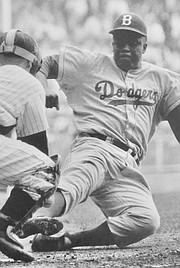Baseball no longer ranks as Our National Pastime. But it still wins the hearts and minds of countless Americans. That's definitely true for a 76-year-old fan like me, who was taken to his first game in 1948 to watch Warren Spahn of the Boston (yes, Boston!) Braves shut out the home-team St. Louis Cardinals.
The absence of Major League Baseball (and other live action, down to Little League and T-Ball) for nobody knows how long leaves a yawning void. Why Life Begins on Opening Day, guru sports columnist Thomas Boswell's celebratory 1984 book, captures the pent-up demand that leads fans (short for "fanatics") like me to cherish the start of each new season.
T.S. Eliot, said to have been a serious fan, could have been alluding in "The Waste Land" to this spring's silent stadiums (rather than matters more existential) when he called April "the cruellest month ... mixing memory and desire." A plangent memory of past diamond dramas now mingles with a deep desire for the umpire's cry of "play ball."
As baseball lingers in suspended animation like the rest of daily life, I do have at least one palliative. It's a 20-disc boxed set, The Official Major League Baseball World Series Film Collection, packed with the highlights of every Fall Classic from 1943 to 2008. Released in 2009, it can still be bought on Amazon and other online purveyors.
As a St. Louis Cardinals fan for seven decades, I'm especially fond of the years featuring my beloved Redbirds: 1943, 1944, 1946, 1964, 1967, 1968, 1982, 1985, 1987, 2004, 2006 -- even though they won only six of those 11 series. Until the early 1960s, the footage was shot in black-and-white, adding to the retro pleasure of again watching Stan Musial, Enos Slaughter, Red Schoendienst and other boyhood idols.
In the package's foreword, sportscaster Bob Costas writes that "each film is a time capsule, each a significant part of the historical record." He expresses "a particular fondness for those early black-and-white versions."
Costas observes that "as we move through the decades and production values become more sophisticated, so does the storytelling. And if some of the simplicity and campy charm of the early films is lost, what's gained is a more textured narrative."
The first film, running 23 minutes, was produced to entertain the millions of Americans serving around the globe in World War II. During a flourish of patriotic opening messages, the narrator reports that 170 American League players and 155 from the National League are on active military duty -- at a time when the rosters of the 16 teams would have totaled about 400.
Babe Ruth salutes servicemen while speaking into a bulky microphone, telling them that all America looks forward to their peaceful pursuit of baseball careers. Ruth appears again in 1947, smoking one of his favored cigars, a year before his death from throat cancer.
Before the first 1943 game between the Cardinals and the New York Yankees begins, an enthusiastic singing is aired of "Take Me Out to the Ballgame." Featured in the introduction of players is Yankees' catcher Bill Dickey, an Arkansas native later enshrined in the Baseball Hall of Fame. Alas, the Yanks handily won the series.
The 1944 film is of particular interest to a native Missourian like me because it recaps the only World Series played entirely in St. Louis -- between the Cardinals and the normally sad-sack Browns, who were moved to Baltimore a decade later.
Those six St. Louis games, not a Subway Series but a Streetcar Series, saw the Cardinals triumph. The Sportsman's Park scenes include some time-warp images:
• No groundskeepers come out to rake the infield smooth every three innings or so. That leads assorted ground balls to take bad hops.
• Very few women are seen in the stands. It was still a man's world at the ballpark.
• Many men are wearing brimmed hats (not caps) along with suits and ties. Series games were dress-up occasions, almost like going to church.
• At game's end, fans are allowed to swarm onto the field and mingle with the players. Implacable security had yet to shackle American lives.
The most riveting of the black-and-white years may be the 1947 meeting of the Yankees and the Brooklyn Dodgers. Highlights include the legendary catch by little-used Dodgers outfielder Al Gionfriddo on a long clout by Yankee legend Joe DiMaggio, who is seen kicking dirt in frustration. The catch is mentioned in Philip Roth's Portnoy's Complaint: "Running! Running! Leaping! Like little Al Gionfriddo -- a baseball player ... who once did a very great thing."
Also captivating is Yankee Bill Bevens' near no-hitter, which would have been a first in the Fall Classic. Bevens finally gave up a hit with two outs in the bottom of the ninth to Cookie Lavagetto. That double won the game for the Dodgers, who still lost the series.
The most important wider moment of the 1947 series took place in Game One's top of the first inning when Jackie Robinson drew a walk. He immediately stole second base. Robinson was the first black player to appear in the World Series, which dates to 1903. That salient fact goes unmentioned in the narrative.
By 1954, with black players joining more and more teams, the World Series film features another legendary fielding play. It's the flabbergasting over-the-shoulder catch deep in the Polo Grounds' vast center field by Willie Mays of the New York Giants.
The next season, Robinson's dazzling World Series steal of home is shown as he slides past Yankees catcher Yogi Berra. In 1956, Berra is pictured leaping to hug Don Larsen, who'd just completed the only perfect game in series history.
Highlights from the 1960s unfold for marathon viewers. In 1960, Bill Mazeroski belts a home run in the bottom of the ninth to give the Pittsburgh Pirates a 10-9 win over the Yankees in the deciding seventh game. In 1964, Bob Gibson strikes out 31 Yankees in 27 innings as the Cardinals beat the Yankees in seven games -- back when strikeouts weren't a dime a dozen.
The 1975 series brings Carlton Fisk's 12th-inning home run. The film replays his famous gesturing with both hands -- a "wave" aimed at keeping his long fly ball fair to give the Red Sox a win over the Cincinnati Reds.
For us Cardinals' fans, the 1985 film depicts a brutal miscarriage of justice committed in the ninth inning of the sixth game. Umpire Don Denkinger called a Kansas City Royal safe at first, on what replays clearly showed should have been an out to end the series in the Redbirds' favor. Instead, the Royals came back to win, then took the championship the next day.
I'll be viewing the remaining films through 2008, knowing that baseball is sometimes a breaker of hearts, even if it has been called merely "a boys' game played by men." This ends the reveries of a bereft fan who knows the watchwords of many a lost season: "Wait till next year."
Jack Schnedler, retired Features editor of the Arkansas Democrat-Gazette, was a 20-year-old sportswriter in Wilmington, Del., when he interviewed Ted Williams in 1963. During Williams' only World Series, in 1946, the Splendid Splinter was flummoxed by the Cardinals' pioneering version of the infield shift.
MovieStyle on 04/17/2020

